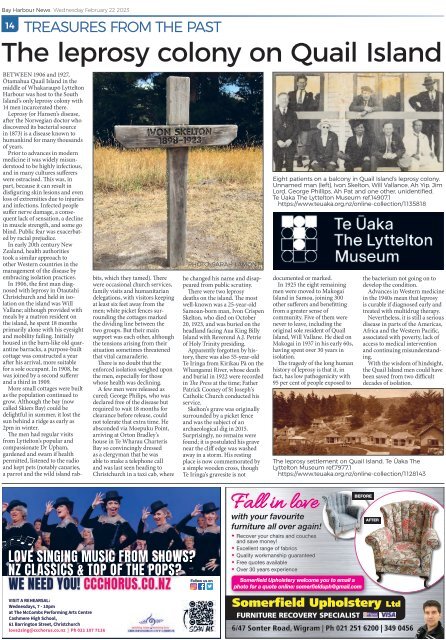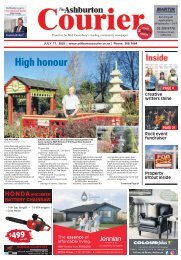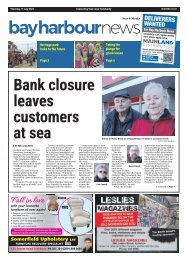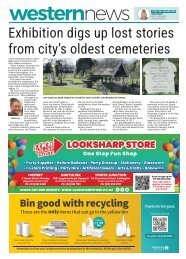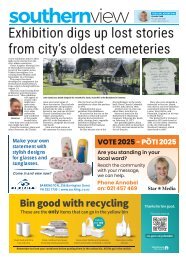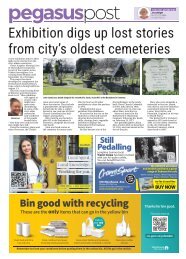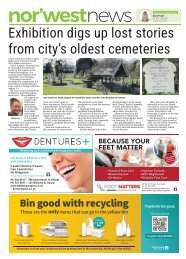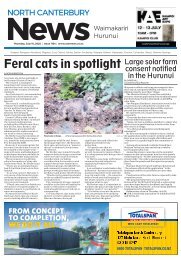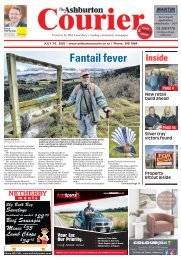Transform your PDFs into Flipbooks and boost your revenue!
Leverage SEO-optimized Flipbooks, powerful backlinks, and multimedia content to professionally showcase your products and significantly increase your reach.
Social icon<br />
Rounded square<br />
Only use blue and/or white.<br />
For more details check out our<br />
Brand Guidelines.<br />
<strong>Bay</strong> <strong>Harbour</strong> News Wednesday <strong>February</strong> <strong>22</strong> <strong>2023</strong><br />
14<br />
TREASURES FROM THE PAST<br />
The leprosy colony on Quail Island<br />
BETWEEN 1906 and 1927,<br />
Ōtamahua Quail Island in the<br />
middle of Whakaraupō Lyttelton<br />
<strong>Harbour</strong> was host to the South<br />
Island’s only leprosy colony with<br />
14 men incarcerated there.<br />
Leprosy (or Hansen’s disease,<br />
after the Norwegian doctor who<br />
discovered its bacterial source<br />
in 1873) is a disease known to<br />
humankind for many thousands<br />
of years.<br />
Prior to advances in modern<br />
medicine it was widely misunderstood<br />
to be highly infectious,<br />
and in many cultures sufferers<br />
were ostracised. This was, in<br />
part, because it can result in<br />
disfiguring skin lesions and even<br />
loss of extremities due to injuries<br />
and infections. Infected people<br />
suffer nerve damage, a consequent<br />
lack of sensation, a decline<br />
in muscle strength, and some go<br />
blind. Public fear was exacerbated<br />
by racial prejudice.<br />
In early 20th century New<br />
Zealand, health authorities<br />
took a similar approach to<br />
other Western countries in the<br />
management of the disease by<br />
embracing isolation practices.<br />
In 1906, the first man diagnosed<br />
with leprosy in Ōtautahi<br />
Christchurch and held in isolation<br />
on the island was Will<br />
Vallane; although provided with<br />
meals by a matron resident on<br />
the island, he spent 18 months<br />
primarily alone with his eyesight<br />
and mobility failing. Initially<br />
housed in the barn-like old quarantine<br />
barracks, a purpose-built<br />
cottage was constructed a year<br />
after his arrival, more suitable<br />
for a sole occupant. In 1908, he<br />
was joined by a second sufferer<br />
and a third in 1909.<br />
More small cottages were built<br />
as the population continued to<br />
grow. Although the bay (now<br />
called Skiers <strong>Bay</strong>) could be<br />
delightful in summer, it lost the<br />
sun behind a ridge as early as<br />
2pm in winter.<br />
The men had regular visits<br />
from Lyttelton’s popular and<br />
compassionate Dr Upham,<br />
gardened and swam if health<br />
permitted, listened to the radio<br />
and kept pets (notably canaries,<br />
a parrot and the wild island rabbits,<br />
which they tamed). There<br />
were occasional church services,<br />
family visits and humanitarian<br />
delegations, with visitors keeping<br />
at least six feet away from the<br />
men; white picket fences surrounding<br />
the cottages marked<br />
the dividing line between the<br />
two groups. But their main<br />
support was each other, although<br />
the tensions arising from their<br />
situation sometimes threatened<br />
that vital camaraderie.<br />
There is no doubt that the<br />
enforced isolation weighed upon<br />
the men, especially for those<br />
whose health was declining.<br />
A few men were released as<br />
cured; George Philips, who was<br />
declared free of the disease but<br />
required to wait 18 months for<br />
clearance before release, could<br />
not tolerate that extra time. He<br />
absconded via Moepuku Point,<br />
arriving at Orton Bradley’s<br />
house in Te Wharau Charteris<br />
<strong>Bay</strong> so convincingly dressed<br />
as a clergyman that he was<br />
able to make a telephone call<br />
and was last seen heading to<br />
Christchurch in a taxi cab, where<br />
PHOTO: SARAH LAMONT<br />
he changed his name and disappeared<br />
from public scrutiny.<br />
There were two leprosy<br />
deaths on the island. The most<br />
well-known was a 25-year-old<br />
Samoan-born man, Ivon Crispen<br />
Skelton, who died on October<br />
20, 1923, and was buried on the<br />
headland facing Aua King Billy<br />
Island with Reverend A.J. Petrie<br />
of Holy Trinity presiding.<br />
Apparently forgotten by history,<br />
there was also 55-year-old<br />
Te Iringa from Kirikau Pā on the<br />
Whanganui River, whose death<br />
and burial in 19<strong>22</strong> were recorded<br />
in The Press at the time; Father<br />
Patrick Cooney of St Joseph’s<br />
Catholic Church conducted his<br />
service.<br />
Skelton’s grave was originally<br />
surrounded by a picket fence<br />
and was the subject of an<br />
archaeological dig in 2015.<br />
Surprisingly, no remains were<br />
found; it is postulated his grave<br />
near the cliff edge was washed<br />
away in a storm. His resting<br />
place is now commemorated by<br />
a simple wooden cross, though<br />
Te Iringa’s gravesite is not<br />
Eight patients on a balcony in Quail Island’s leprosy colony.<br />
Unnamed man (left), Ivon Skelton, Will Vallance, Ah Yip, Jim<br />
Lord, George Phillips, Ah Pat and one other, unidentified.<br />
Te Ūaka The Lyttelton Museum ref.14907.1<br />
https://www.teuaka.org.nz/online-collection/1135818<br />
documented or marked.<br />
In 1925 the eight remaining<br />
men were moved to Makogai<br />
Island in Samoa, joining 300<br />
other sufferers and benefitting<br />
from a greater sense of<br />
community. Five of them were<br />
never to leave, including the<br />
original sole resident of Quail<br />
Island, Will Vallane. He died on<br />
Makogai in 1937 in his early 60s,<br />
having spent over 30 years in<br />
isolation.<br />
The tragedy of the long human<br />
history of leprosy is that it, in<br />
fact, has low pathogenicity with<br />
95 per cent of people exposed to<br />
the bacterium not going on to<br />
develop the condition.<br />
Advances in Western medicine<br />
in the 1940s mean that leprosy<br />
is curable if diagnosed early and<br />
treated with multidrug therapy.<br />
Nevertheless, it is still a serious<br />
disease in parts of the Americas,<br />
Africa and the Western Pacific,<br />
associated with poverty, lack of<br />
access to medical intervention<br />
and continuing misunderstanding.<br />
With the wisdom of hindsight,<br />
the Quail Island men could have<br />
been saved from two difficult<br />
decades of isolation.<br />
The leprosy settlement on Quail Island. Te Ūaka The<br />
Lyttelton Museum ref.7977.1<br />
https://www.teuaka.org.nz/online-collection/1128143<br />
Fall in love<br />
before<br />
with your favourite<br />
furniture all over again!<br />
• Recover your chairs and couches<br />
and save money!<br />
• Excellent range of fabrics<br />
• Quality workmanship guaranteed<br />
• Free quotes available<br />
• Over 30 years experience<br />
Somerfield Upholstery welcome you to email a<br />
photo for a quote online: somerfielduph@gmail.com<br />
after<br />
Somerfield Upholstery Ltd<br />
FURNITURE RECOVERY SPECIALIST<br />
6/47 Sonter Road, Wigram | Ph 021 251 6200 | 349 0456


